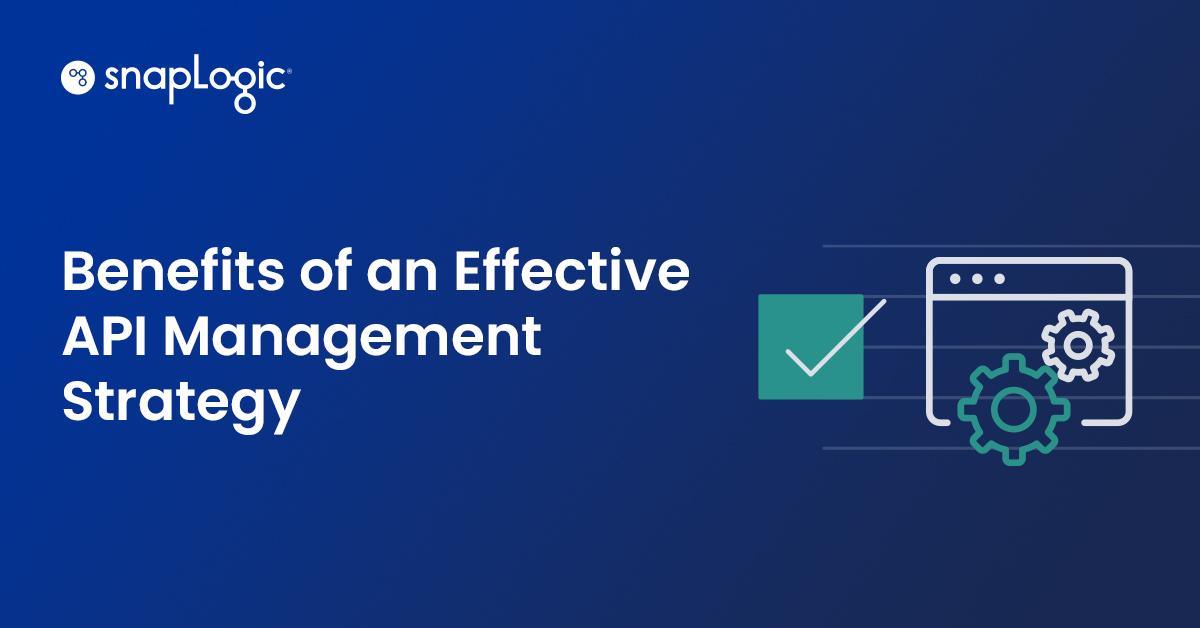API management is the process of overseeing the entire life cycle of application programming interfaces (APIs) within an organization. API lifecycle management includes designing, publishing, documenting, and monitoring APIs to ensure they meet the needs of the organization and its end users. Many companies are realizing that API management must be part of their API strategy as exponential growth in use of APIs brings about challenges of scalability and management.
API management is important because APIs are crucial for enabling communication and integration between different software and data systems. APIs allow different apps to share data and functionality, which can greatly improve the efficiency and flexibility of an organization. Hand-coding APIs used to be the main method however with the demands of faster time-to-market there are low-code no code API creation tools today. For example, APIs that used to take weeks to hand-code only take days or hours to create with SnapLogic’s low-code iPaaS platform. You can connect your Salesforce CRM to a Snowflake database then to a Marketo Marketing Campaign all with an API that was created by snapping pictures together.
As APIs have become easier to create, there are new possibilities. Such as creating new APIs that can enable monetization opportunities for organizations. A typical use case for API monetization would be that of Expedia (travel website). Any app that wants to embed or use the capabilities of Expedia would use the Expedia API and pay for that use. The Expedia API brings in millions of dollars of revenue for Expedia and is a key part in Expedia’s API strategy. As APIs are becoming the key to business ecosystems, they need to be protected and properly managed with an API management tool.
Several key components of an API management platform
API design
This involves planning and designing APIs to ensure they are easy to use, scalable, and secure. This includes defining the structure and format of the API, as well as deciding which data and functionality should be exposed through the API. The design will also vary depending on whether it’s an internal API (i.e. sharing information within an organization) or external API (i.e. sharing information to the outside of an organization, like the Expedia use case mentioned above).
API publishing
This involves providers making the API available to API developers who want to use it. This typically involves creating documentation and other resources that developers can use to learn about the API and start using it in their own applications. A developer portal is used to allow developers and partners to discover, register, and obtain access to APIs. The developer portal provides an intuitive UI for developers to explore and consume APIs.
API documentation
This involves providing detailed information about the API, including its functionality, versioning, data formats, and security protocols. This is important because it allows developers to understand how the API works and how to use it effectively.
API monitoring
This involves tracking the real-time usage and performance of the API to ensure it is meeting the needs of the organization and its clients. This can include monitoring of API usage metrics such as the number of API requests, the amount of data transferred, and the response times of the API. By monitoring these metrics via a dashboard within the API management tool an organization can also optimize their APIs for performance and security.
API security
- Use authentication and authorization: authentication is the process of verifying the identity of a user, while authorization is the process of granting access to certain resources. Implementing both authentication and authorization strategies is essential for protecting APIs. The most common authentication method is OAuth 2.0, which allows users to securely login to an application using their existing credentials. Authorization strategies should be used to control which users have access to specific resources.
- Implement input validation: Input validation is the process of validating the data that is sent to an API. This helps to protect the API from malicious attacks such as SQL injection and cross-site scripting. All incoming data should be validated to ensure that it is in the correct format and that it does not contain any malicious content.
- Implement rate limiting: Rate limiting is a security technique that limits the number of requests that can be made to an API in a given period of time. This helps to prevent the API from being overwhelmed by malicious requests.
- Make sure to take full advantage of automation in API security due to the scale of the issue. Automated alerts can be set up to notify administrators of any problems that may arise with the API.
Four major benefits of API management that should be part of your API strategy
Improved developer experience
By providing clear and detailed documentation, as well as tools and support for developers, organizations can make it easier for developers to use their APIs (can be either internal APIs or external APIs) , which can increase adoption and usage of APIs.
Enhanced security
Over 66% of cybersecurity attacks in 2021 were due to unsecured APIs according to IBM. API security should be one of the top considerations in an effective API management strategy. By implementing API security policies and monitoring the usage of APIs via an API gateway, organizations can protect their data and systems from unauthorized access and potential security threats.
Increased efficiency
By allowing different software systems to share data and functionality through APIs, organizations can reduce the need for redundant data entry and other manual processes, which can improve the overall efficiency of their operations.
Greater flexibility
By exposing data and functionality through APIs, organizations can make it easier for different applications to integrate and communicate with each other, which can increase the flexibility of their IT systems.
SnapLogic’s API manager
API management is an essential component of modern software development and integration. There are many API management tools out there but few have both iPaaS and API management together in a unified platform. With an API management solution like SnapLogic’s API manager, businesses can improve the developer experience, enhance security, increase efficiency, and increase flexibility. This can help organizations to get the most out of their data and IT systems, and stay ahead of the competition as they streamline their digital transformation.











